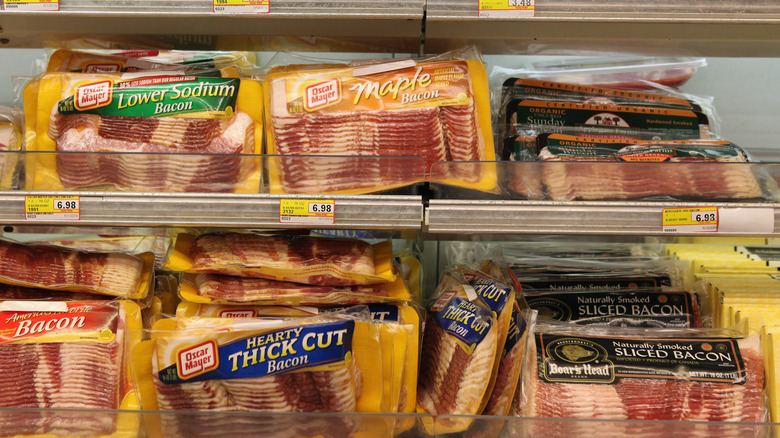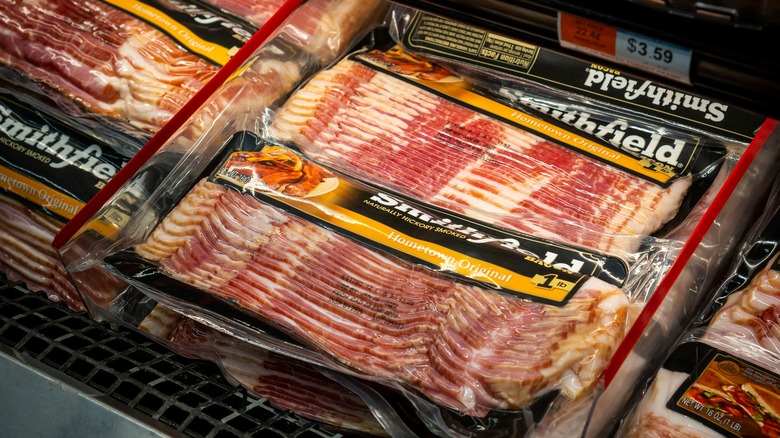Why Does Bacon Always Come In The Worst, Unresealable Packaging?
For years, shoppers have complained about bacon's nonsensical packaging. Most notably, in 2023, marketing professional Kat Thomas went viral with her TikTok calling out Oscar Mayer for selling unresealable packs. While frustrating, bacon manufacturers are responding to safety concerns, traditional household eating habits, and even the national government with that awkward container.
Bacon's unique window packaging, known as a shingle pack, addresses U.S. government concerns about false advertising of bacon as leaner than it actually is. The U.S. Department of Agriculture mandated in 1973 that bacon packages must show at least 70 percent of a sample slice to consumers; flipping packaging to the back window thereby reveals bacon's true fat content. The clear pack also helps buyers see any discoloration or mold on the bacon before opening, and its skintight wrapping helps keep the product fresher longer. By vacuum sealing bacon, manufacturers are removing as much air as possible from the package, making it harder for oxidation to occur, which could lead to bacterial contamination.
In interviews with TODAY.com, representatives of both Smithfield and Applegate noted that its customers tend to consume the entire bacon package in one sitting, so it didn't need to be resealable. (That said, the share of one-person households in the U.S. has increased every decade since the 1940s through the 2020 census.) Alternately, the Wright brand does sell bacon in clear, resealable bags — but that convenience comes with a higher price tag. As consumers shop for value in the face of rising costs, the highest-selling bacon brands are also the least expensive, like grocery private labels and Hormel.
The business case against updating bacon packaging
While reusable packs could be the key to encouraging Americans to buy more bacon, experts note that packaging costs factor into 10% or more of a product's price in stores. Combine this with increasing costs for pork production overall, and bacon manufacturers are challenged: change the packaging to better align with modern household cooking trends or stay the course from the past 50+ years to keep costs down? Some have resorted to shrinkflation, reducing how much product is in the package alongside optimizing the package itself. As far back as 2010, Hormel was called out for changing the standard bacon portion in its packs from a pound to 12 ounces.
The bacon industry continues to boom despite other challenges in recent years, such as international pressure caused by tariffs and an outbreak of African swine fever in China. In fact, grocery store bacon prices rose by 6.9% year over year from May 2023 to May 2024. Consistent demand drives the retail pricing strategy. Bacon is a relative value compared to other meat products, especially since when bacon is on sale, it tends to be at a substantial discount.
Bacon manufacturers are notoriously cagey about the topic of updating the hated shingle pack. In a Bloomberg article from 2016, reps from Hormel, Oscar Mayer, and Smithfield all declined to discuss it. The reality appears to be that bacon turns a tidy profit for major brands, and changing the package to be resealable would cut into those earnings. Until more manufacturers follow Wright's lead, you can keep any unused raw bacon in a zip-lock bag or wrapped in aluminum foil or plastic wrap in the refrigerator for up to one week.

